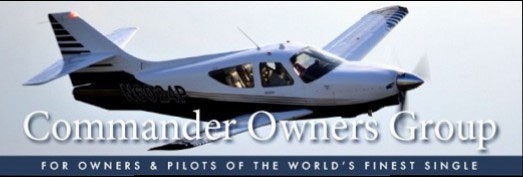South Burlington, VT
- Aircraft Year
- 1978 580
- Aircraft Type
- Super Commander
- Reg Number
- N555LP
- Serial Number
- 14405
Hi All,
I am pleased, and relieved, to announce successful fabrication of first article new parts for Service Bulletins 112-56B and 114-12B. As you may know, few aircraft ever got any kit, let alone the final factory kit, because it came along so late in the Rockwell years. Many of the aircraft that got earlier Rockwell renditions of this repair during production have failed again.
The 114B/TC models use a different design for the stub fin rib/doubler, without any service life problems to my knowledge. Our new kit converts the stub fin of any 112/A/B/TC/TCA or 114/A to the proven 114B/TC design.
The stub fin holds the entire empennage, onto your airplane. All pitch and yaw loads are transmitted to the fuselage through this critical section. My personal tolerance for any cracks in this structure is zero. What's yours?
This is our most complex part undertaking to date:
1. SolidWorks design capture and tool design (as usual).
2. Five main parts: (rib, doubler, and three spacer strips).
3. CNC routing of rib, doubler, and strips.
4. 20-ton press (full custom tooling) of rib and doubler flanges.
5. 10-ton press of rib and doubler strengthening beads (custom tooling)
6. Fluting of rib and doubler (custom tooling).
7. Dimpling of "lightening" holes (three custom die sets).
8. All the usual treat, prep, and finish.
I attached our drawing of the flange dies (just one part of the tooling) so you can get a feel for what is entailed in an undertaking like this.
We are doing the first installation now, see pic, to be immediately followed by a second.
Next week, I will post a special offering for all of you who need kits now, or want to put one on the shelf. Your response will help me decide how big a batch we can run and how low we can price.
I am hoping for your enthusiastic support of this endeavor as the development cost and time have not been trivial.
The offering is a step-by-step DER Repair Report, accompanied by a Form 8110-3 airworthiness approval, with the parts fabricated and supplied by Aerodyme as an included subcontract service to the mechanic you choose to do the installation.
We appreciate, and need, your support as always,
Jim and Martine
I am pleased, and relieved, to announce successful fabrication of first article new parts for Service Bulletins 112-56B and 114-12B. As you may know, few aircraft ever got any kit, let alone the final factory kit, because it came along so late in the Rockwell years. Many of the aircraft that got earlier Rockwell renditions of this repair during production have failed again.
The 114B/TC models use a different design for the stub fin rib/doubler, without any service life problems to my knowledge. Our new kit converts the stub fin of any 112/A/B/TC/TCA or 114/A to the proven 114B/TC design.
The stub fin holds the entire empennage, onto your airplane. All pitch and yaw loads are transmitted to the fuselage through this critical section. My personal tolerance for any cracks in this structure is zero. What's yours?
This is our most complex part undertaking to date:
1. SolidWorks design capture and tool design (as usual).
2. Five main parts: (rib, doubler, and three spacer strips).
3. CNC routing of rib, doubler, and strips.
4. 20-ton press (full custom tooling) of rib and doubler flanges.
5. 10-ton press of rib and doubler strengthening beads (custom tooling)
6. Fluting of rib and doubler (custom tooling).
7. Dimpling of "lightening" holes (three custom die sets).
8. All the usual treat, prep, and finish.
I attached our drawing of the flange dies (just one part of the tooling) so you can get a feel for what is entailed in an undertaking like this.
We are doing the first installation now, see pic, to be immediately followed by a second.
Next week, I will post a special offering for all of you who need kits now, or want to put one on the shelf. Your response will help me decide how big a batch we can run and how low we can price.
I am hoping for your enthusiastic support of this endeavor as the development cost and time have not been trivial.
The offering is a step-by-step DER Repair Report, accompanied by a Form 8110-3 airworthiness approval, with the parts fabricated and supplied by Aerodyme as an included subcontract service to the mechanic you choose to do the installation.
We appreciate, and need, your support as always,
Jim and Martine
